2012广东省最新高考英语专题解析课件:语法填空[解题密招]
文档属性
| 名称 | 2012广东省最新高考英语专题解析课件:语法填空[解题密招] | 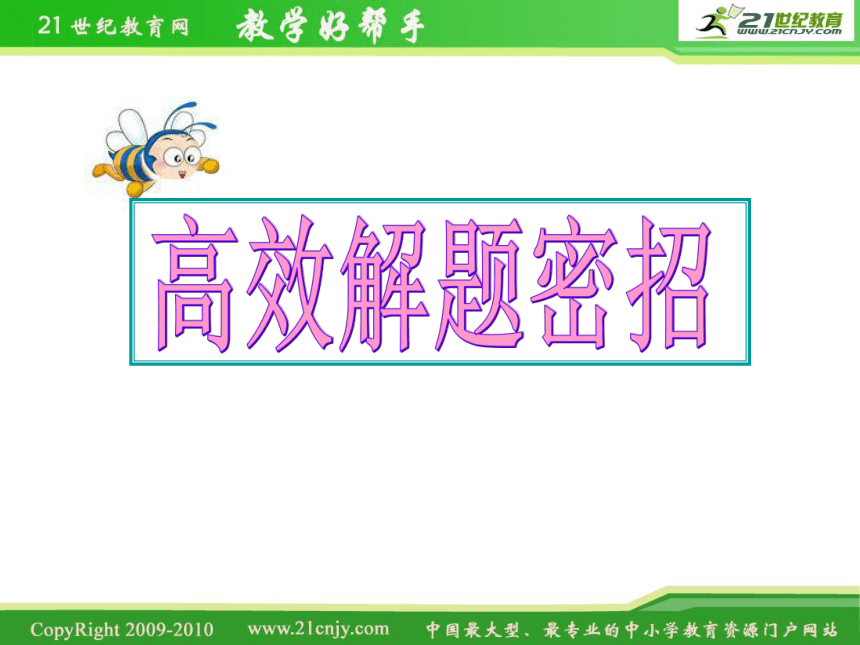 | |
| 格式 | zip | ||
| 文件大小 | 269.9KB | ||
| 资源类型 | 教案 | ||
| 版本资源 | |||
| 科目 | 英语 | ||
| 更新时间 | 2012-03-14 21:15:15 | ||
图片预览

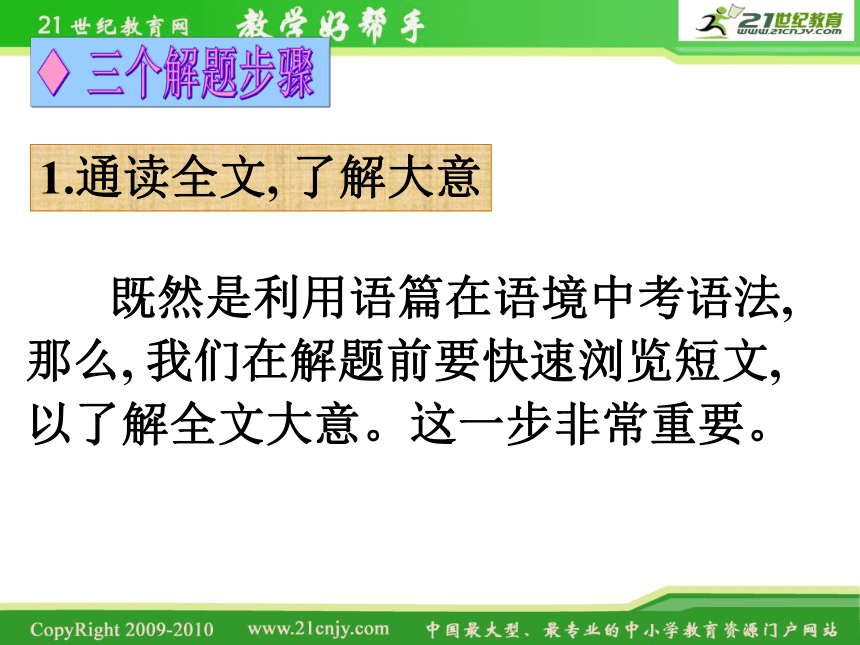
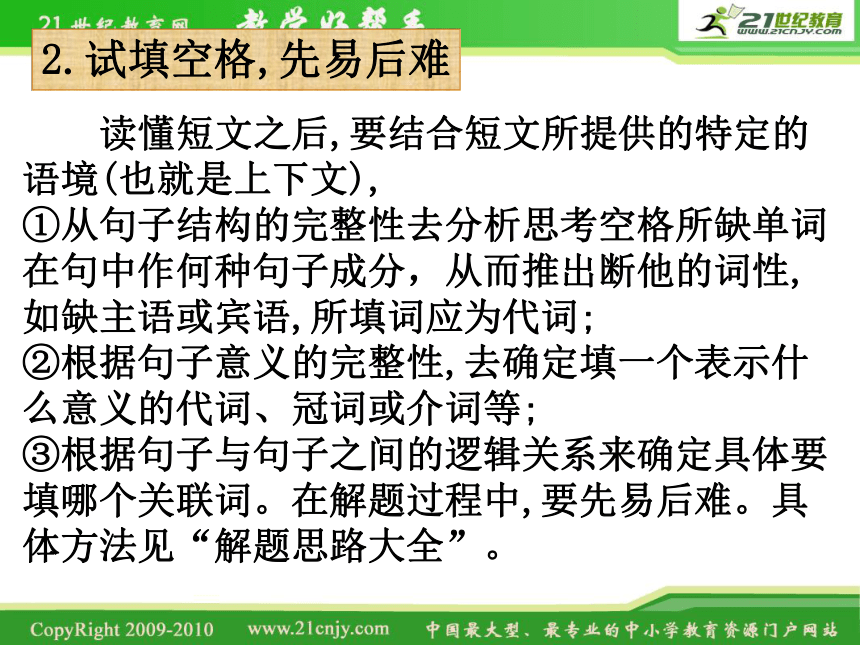
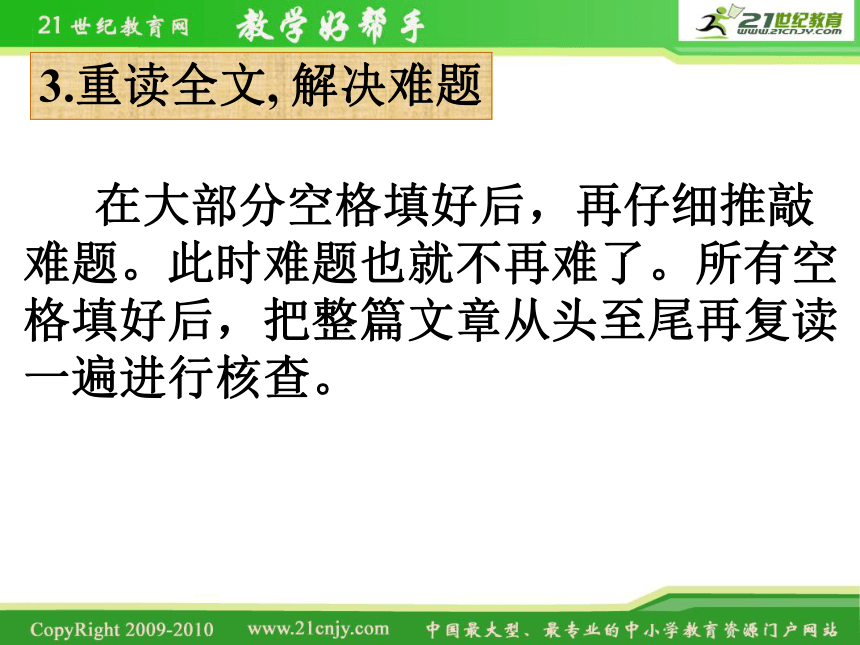

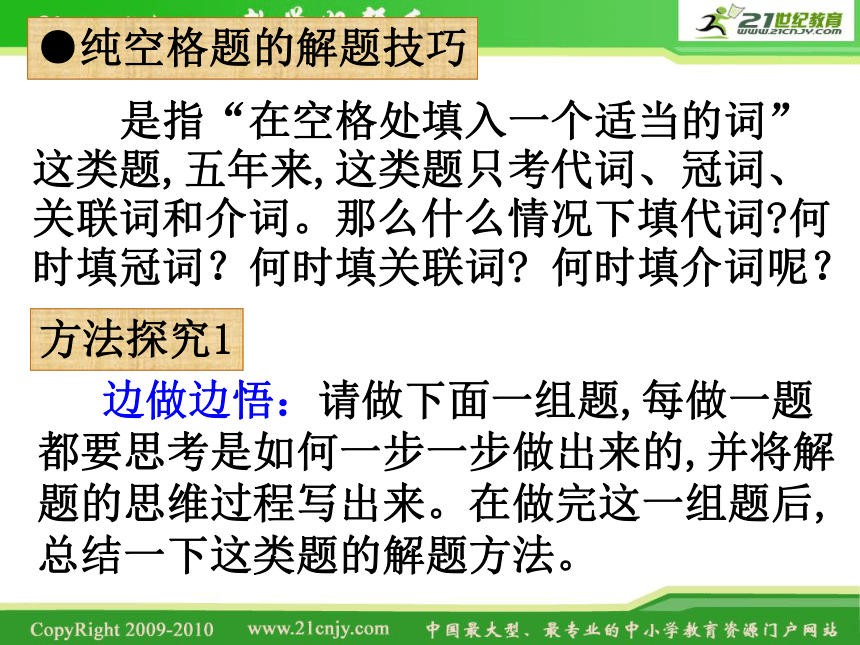
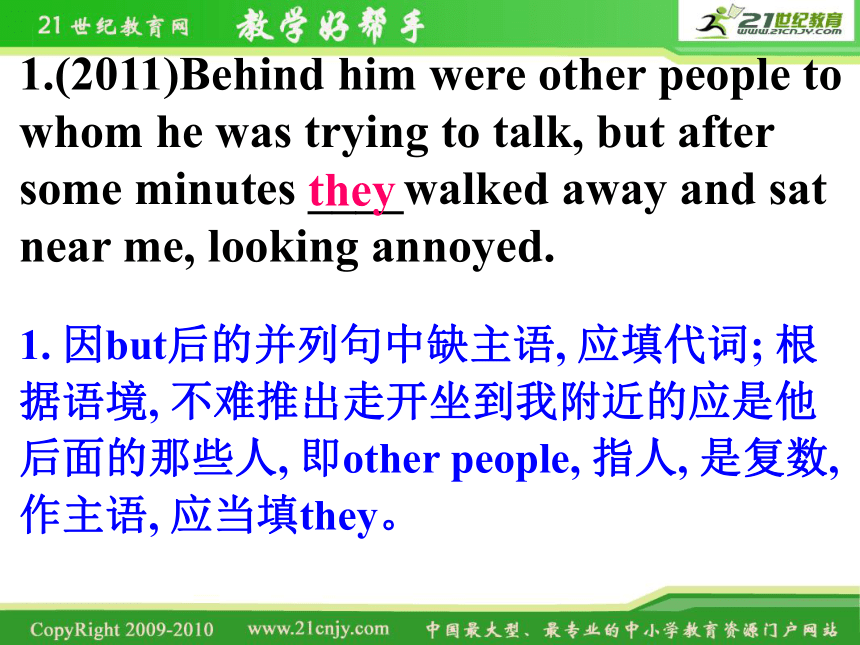

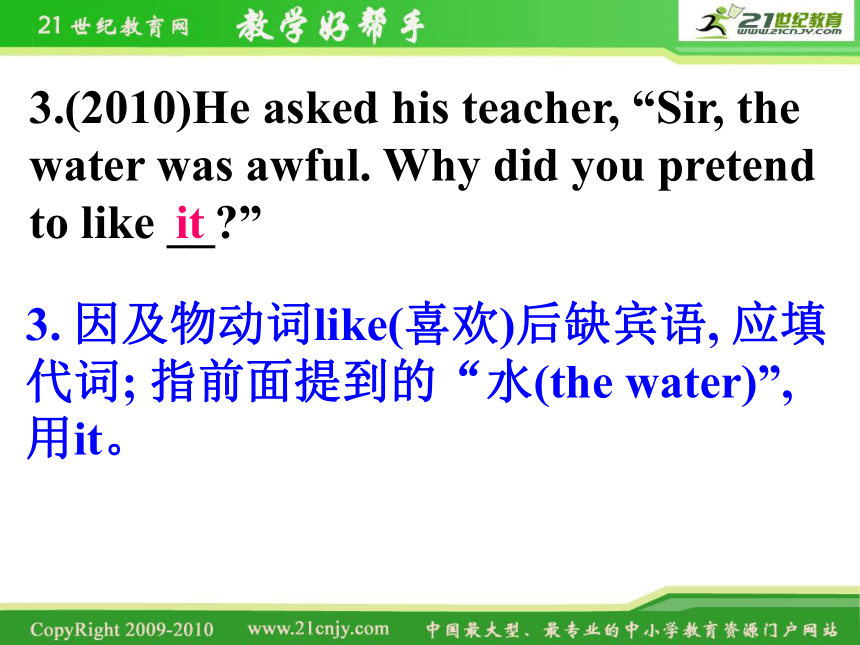
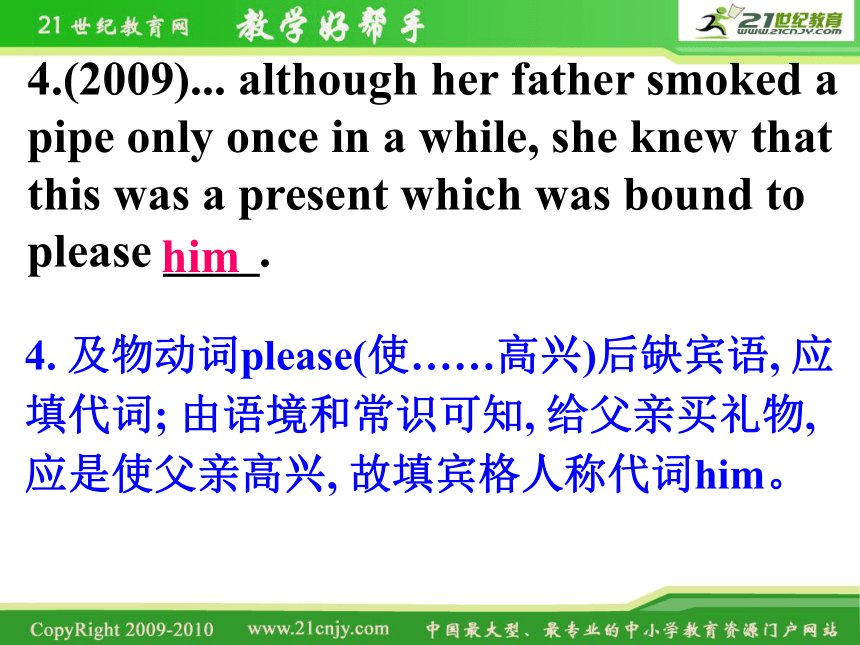
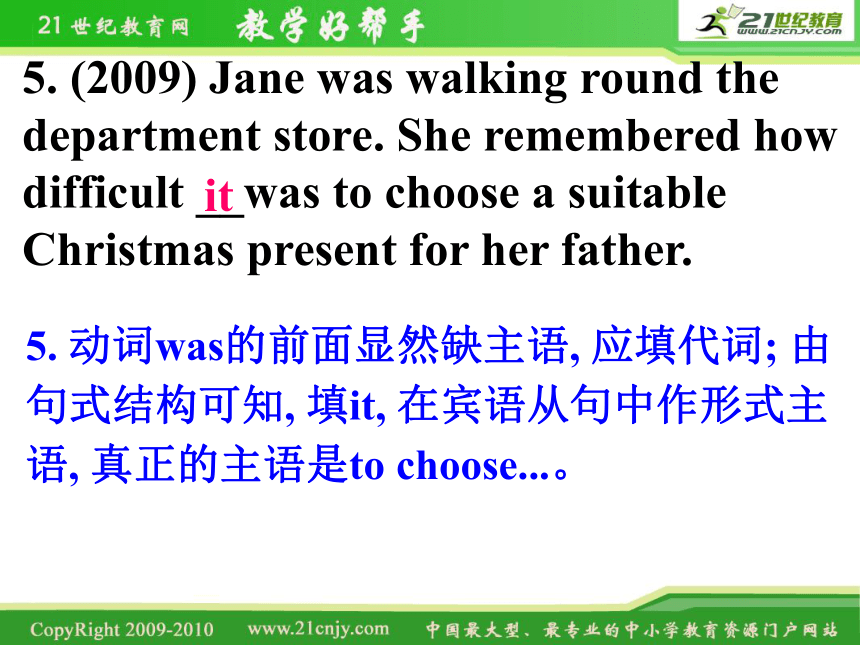
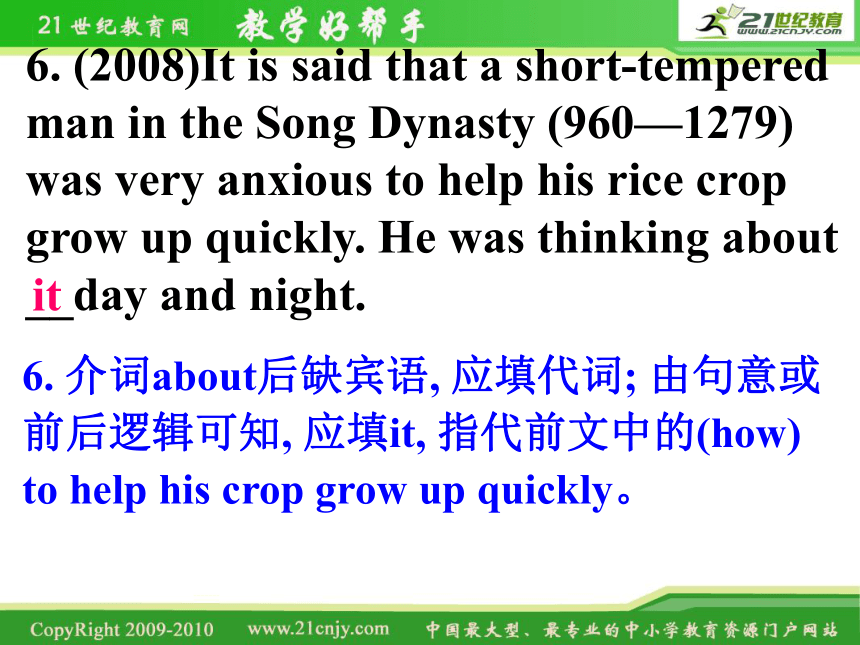
文档简介
(共77张PPT)
既然是利用语篇在语境中考语法, 那么, 我们在解题前要快速浏览短文, 以了解全文大意。这一步非常重要。
1.通读全文, 了解大意
读懂短文之后,要结合短文所提供的特定的语境(也就是上下文),
①从句子结构的完整性去分析思考空格所缺单词在句中作何种句子成分,从而推出断他的词性,如缺主语或宾语,所填词应为代词;
②根据句子意义的完整性,去确定填一个表示什么意义的代词、冠词或介词等;
③根据句子与句子之间的逻辑关系来确定具体要填哪个关联词。在解题过程中,要先易后难。具体方法见“解题思路大全”。
2.试填空格,先易后难
在大部分空格填好后,再仔细推敲难题。此时难题也就不再难了。所有空格填好后,把整篇文章从头至尾再复读一遍进行核查。
3.重读全文, 解决难题
解答语法填空的基本功是懂得句子的结构分析, 准确理解句子意思, 善于把握上下句之间的逻辑关系。以下按命题形式和考点类型的不同探讨解题思路和解题技巧。
是指“在空格处填入一个适当的词”这类题,五年来,这类题只考代词、冠词、关联词和介词。那么什么情况下填代词 何时填冠词?何时填关联词 何时填介词呢?
●纯空格题的解题技巧
边做边悟:请做下面一组题,每做一题都要思考是如何一步一步做出来的,并将解题的思维过程写出来。在做完这一组题后,总结一下这类题的解题方法。
方法探究1
1.(2011)Behind him were other people to whom he was trying to talk, but after some minutes ____walked away and sat near me, looking annoyed.
1. 因but后的并列句中缺主语, 应填代词; 根据语境, 不难推出走开坐到我附近的应是他后面的那些人, 即other people, 指人, 是复数, 作主语, 应当填they。
they
2.(2011)I rose from my seat I sat next to the man and introduced myself. We had an amazing conversation. He got off the bus before me and I felt very happy the rest of the way home.
I’m glad I made a choice. It made ___ of us feel good.
2. 作made的宾语, 用代词, 由上文 “We (I and the mentally disabled man) had an amazing conversation”可知, 指作者和那个智障人“两个人”,故填both。
both
3.(2010)He asked his teacher, “Sir, the water was awful. Why did you pretend to like __ ”
3. 因及物动词like(喜欢)后缺宾语, 应填代词; 指前面提到的“水(the water)”,用it。
it
4.(2009)... although her father smoked a pipe only once in a while, she knew that this was a present which was bound to please ____.
4. 及物动词please(使……高兴)后缺宾语, 应填代词; 由语境和常识可知, 给父亲买礼物, 应是使父亲高兴, 故填宾格人称代词him。
him
5. (2009) Jane was walking round the department store. She remembered how difficult __was to choose a suitable Christmas present for her father.
5. 动词was的前面显然缺主语, 应填代词; 由句式结构可知, 填it, 在宾语从句中作形式主语, 真正的主语是to choose...。
it
6. (2008)It is said that a short-tempered man in the Song Dynasty (960—1279) was very anxious to help his rice crop grow up quickly. He was thinking about __day and night.
6. 介词about后缺宾语, 应填代词; 由句意或前后逻辑可知, 应填it, 指代前文中的(how) to help his crop grow up quickly。
it
7. (2007) I wanted to reward the old woman for the trouble I had caused __ .
7. 因(that) I had caused是定语从句, 先行词是trouble, 代表先行词的关系代词that在从句中作宾语, 被省略了; 由搭配cause sb.trouble(=cause trouble for sb.给某人造成麻烦)可知, 填宾语人称代词her, 指代the old woman。
her
当句子缺主语或宾语时,填_____。
因为充当主语或宾语的应是名词或代词,而在语法填空的纯空格中一般是不要求考生填名词的,所以只要句子缺主语或宾语,你就填代词。此时,要根据前后语境,看该空格是指人还是事物,指男还是指女,是单数还是复数。除人称代词外,也有可能是填________等。还有可能是填作形式主语或形式宾语的__,替代后面作真正的主语或宾语的不定式、动名词或从句。
代词
不定代词
it
边做边悟:请做下面一组题, 每做一题都要思考
是如何一步一步做出来的, 并将解题的思维过程
写出来。在做完这一组题后, 总结一下这类题的
解题方法。
1.(2011)I sat next to the man and introduced myself. We had __ amazing conversation.
方法探究2
1. 作宾语的名词amazing conversation前应填限定词; 根据习惯搭配可知填不定冠词an, 因为have a conversation 意为“谈话”。
an
2.(2010)A young man, while traveling through a desert, came across a spring of clear water. ____water was sweet.
2. 作主语的名词前应填限定语; 特指前面提到的clear water, 相当于“这”种清泉, 故填The。
The
3.(2010)The young man went home with a happy heart.
After the student left, the teacher let _______ student taste the water.
3. 作let宾语的名词前, 应填限定词;相对于送水的这个学生(the student)来说, 应是给他的“另外一个”学生尝一尝, 故填another。
another
4. (2009) Besides, shopping at this time of the year was not _ pleasant experience: people stepped on your feet
4. 句中experience意为“经历”, 是可数名词;作表语的名词experience前应填限定词; 由冒号之后的内容可知, 一年的这个时候去购物并不是一次愉快的经历, 表示“一次”用不定冠词, 故填a。
a
5.(2008)It is said that a short-tempered man in the Song Dynasty (960 — 1279) was very anxious to help ___rice crop grow up quickly.
5. 在作宾语的名词前, 应当填限定词; 由句意和常识可知, 这个急性子人急于使“他自己的”禾苗长得快, 故填形容词性物主代词his。
his
6.(2007)the head of the village was tying up his horse to my car to pull it to __ small town some 20 kilometres away where there was a garage.
6. 作宾语的名词small town前应填限定语; 由句意可知, 此处指将车拉到离那里大约有20公里远的“一个小镇”去修, 表示“一个”, 用不定冠词, small以辅音开头, 故填a。
a
7. (2007) I had noticed three hens running free in my hostess’s courtyard and that night one of them ended up in a dish on my table. ___________ villagers brought me goat’s cheese and honey.
7. 作主语的名词villagers前应填限定词; 相对招呼我在她家吃住的那个old peasant woman, 拿goat’s cheese and honey来同我饮酒聊天的应是“其他的(Other)” 村民, 或者理解为“有些(Some)”村民。
Other/Some
在作主语、__语或___语的名词或“形容词+名词”前,填限定词。
限定词是指冠词、形容词性物主代词,或可以作定语的不定代词等。此时,要根据句子的意思来确定空格的语境意义,由此来判断具体填什么词。如表示特指,大体相当于“这、这些、那、那些”时用_________;表示“一(个,本,座……)”时用不定冠词a或an;表示“某人的”,用_________;表示“一些”用some,表示“另一个”用another,表示“其他的”用other等。
物主代词
宾
表
定冠词the
边做边悟: 请做下面一组题, 每做一题都要思考是如何一步一步做出来的, 并将解题的思维过程写出来。在做完这一组题后, 总结一下这类题的解题方法。
1.(2011)I didn’t want to be laughed at for talking to him but I didn’t like leaving him ___his own either.
方法探究3
1. 因on one’s own(=alone)是固定搭配, 所以填on。
on
2.(2010)His teacher took a deep drink and thanked his student very much for the sweet water. The young man went home _____a happy heart.
2. 名词a happy heart 在句中不作主语, 也不作动词的宾语, 就应是作介词的宾语, 空格处应填介词; 由句意可知, 是指这个年轻人“带着”愉快的心情回家, 表示“带着”用with, 介词短语with a happy heart作伴随状语, 修饰谓语went home。
with
3.(2009)She found some good quality pipes __ sale.
3. 名词sale在句中不作主语, 也不作动词的宾语,就应是作介词的宾语, 空格处应填介词; 因表示“出售”的on sale是固定搭配, 故填on。
on
4.(2009)When Jane got home, with her small but well-chosen present in her bag, her parents were already __ table having supper.
4. 名词(table)在句中不作主语, 也不作动词的宾语, 就应是作介词的宾语; 由having supper可知,填at; 因为at table表示“在餐桌边, 在进餐”, 也是习惯搭配。
at
5. (2008)Chinese proverbs are rich and they are still widely used in Chinese people’s daily life. ________ these proverbs there are often interesting stories.
5. 因名词these proverbs在句中不是作主语, 也不是作动词的宾语, 应当是作介词的宾语, 即空格处应填介词; 由表示存在的句型可知, 应当是指在某个地方或某个时间存在, 此处应是指“在中国的这些成语故事的背后/里面”常常有有趣的故事, 故填介词Behind或In。注意, 在句首, 要大写开头。
Behind/In
6.(2008)He was very tired _________ doing this for a whole day, but he felt very happy.
6. 因动名词短语doing this不是作主语, 也不是作动词的宾语, 应是作介词的宾语, 即空格处应填介词; 又因“他感到很累”应是“在他做了一整天事之后”, 表示“在……之后”,用介词after; 另外be tired from doing (因做某事而累)是固定搭配, 故也可填from。
after/from
7.(2007)I realized that the villagers who had gathered around me were arguing as to who should have the honour of receiving me __ a guest in their house.
7. 因名词a guest在句中不作主语, 也不作动词的宾语, 可推断是作介词的宾语, 应填一个介词; 又由句意“把我当作客人来接待(receive sb.as...)”, 可知填介词as。
as
8.(2007)When the time came for me to say goodbye to my friends in the village, I wanted to reward the old woman __ the trouble I had caused her.
8. 因名词the trouble在句中不作主语, 也不作动词的宾语, 应当是作介词的宾语; 表示“因……而酬谢 / 报答某人”是reward sb.for sth., 故填for。
for
当空格后的名词、代词或动名词不是作主语、表语,也不是作动词的___语时,填___词。
因为名词和代词最典型的用法是作主语或宾语,既然不作主语和动词的宾语,就应是作介词的宾语了,所以要填介词。具体填什么介词,由介词与该___词的搭配及其意义(如上述题1~5)来决定,也可能是由___词或谓语与介词的句式搭配(如上述6~8题)来决定。
宾
介
名
动
1.(2011)My friends walked me to the bus stop and waited with me ____ the bus arrived.
方法探究4
1. 空格前后都是句子且这两个句子之间没有关联词, 应填关联词; 由两句之间的逻辑关系可知, 是“等到车来”, 表示“直到”用until, 引导时间状语从句。
until
2.(2011)Behind him were other people to _____ he was trying to talk, ...
2. 空格前后都是句子且这两个句子之间没有关联词, 应填关联词; 后面一句应当这样理解he was trying to talk to the people, 可见, 后面一句是定语从句, 先行词是people, 直接在介词后应用关系代词whom引导定语从句。
whom
3.(2010)He filled his leather container so that he____ could bring some back to an elder had been his teacher.
3. 因空格前后都是句子, 且这两个句子之间没有关联词, 故一定是填关联词; 由句意和逻辑可知, “这个长者是他的老师”, 可判断空格后这个句子是一个定语从句, 先行词是an elder, 从句中缺主语; 替代先行词且在定语从句中作主语, 应填who, 引导定语从句。
who
4.(2010)We understand this lesson best ____ we receive gifts of love from children.
4. 因空格前后都是句子, 且这两个句子之间没有关联词, 故一定是填关联词; 根据两句之间的逻辑关系, 填表示“在……的时候”的when, 引导时间状语从句。
when
5.(2009)Jane paused in front of a counter _____ some attractive ties were on display.
5. 因空格前后都是句子, 且这两句之间没有关联词, 必定是填关联词; 由句意和逻辑可知, “陈列引人注目的领带”应是在“柜台”里, 因此, a counter是先行词, 其后是定语从句,要填的词在从句中作地点状语, 故填关系副词where。
where
6.(2008)One day, he came up with an idea ____ he would pluck up all of his crop a few inches.
6. 空格前后都是句子且这两个句子之间没有联关词, 应填关联词; 由前后的意义关系可知, 空格后是同位语从句, 说明idea的具体内容; 名词性从句的结构和意义已非常完整, 故用that引导。
that
7. (2008) He was very tired after doing this for a whole day, ___ he felt very happy since the crop did “grow” higher.
7. 空格前后都是句子且这两句之间没有关联词, 应填关联词; 又因后句的he felt very happy与前句的He was very tired是转折关系,故填but。
but
8. (2007)I was wondering where I was going to spend the night when I realized that the villagers who had gathered around me were arguing as to ___ should have the honour of receiving me as a guest in their house.
8. 因as to(关于)是介词, 其后应接宾语; 由should have...可知, as to后是宾语从句, 宾语从句中should have是谓语, 前面缺主语; 由常识可知“有幸接待我”的应是人, 故用who引导宾语从句。
who
9. (2007)...the head of the village was tying up his horse to my car to pull it to a small town some 20 kilometres away _____ there was a garage.
9. 空格前后都是句子且这两个句子之间没有关联词, 应填关联词; 由两句间的逻辑关系可知,后句是定语从句修饰a small town, 空格要填的词在定语从句中作地点状语, 故用关系副词where(=in which)引导定语从句。
where
10.(2010佛山二模)The robbers came in at about 22: 00 on Saturday ____ left at 07: 00 on Sunday.
10. 因left...与came...是并列关系, 一起作谓语, 故填并列连词and。
and
当空格前后都是句子(一个主谓关系算一个句子),且这两个句子之间没有关联词时,填 ______;若并列的两个或几个单词或短语之间没有连词,填表示联合、选择、转折等意义的连词(如上述第10题)。
关联词
具体填哪个关联词,由两个或几个单词、短语或句子之间的逻辑关系来决定。若是句子与句子之间,还要分析整个句子的结构,分清主句与从句,弄清从句在整个句子中作何种成分,确定是从句类型(在整个句子中作主语、宾语、表语、同位语就是______从句;作定语叫定语从句;
名词性
表示时间、地点、原因、条件、结果等的从句叫 _____从句),以及引导该类从句的关联词的使用特点(如引导定语从句的关联词一定是代表先行词并在从句中作句子成分的;引导名词性从句的关联词,that没有任何意思也不作任何句子成分,即句子结构和意思完整时即填______,而if或whether有意思但不作句子成分,who, whom, which,when,where,how等则有意思也作句子成分)来决定。
that
状语
1.(2010茂名二模)Listen to these words from Darwin P. Kingsley: “You have powers you never dreamed of. You can do things you never thought you _____ do. There are no limitations in what you can do except the limitations of your own mind.”
方法探究5
1. 因空格后的do是原形, 而thought是一般过去时, 所以空格处应当是填情态助动词; 又由前面You can do things和后文的you can do可以提到启示, 此处也填can, 只不过用其过去式(由thought可知), 故填could。句意是“你能做你(以前)从未想到过你能做的事”。
could
2.(2010茂名一模)I explained that while I didn’t carry any cash, I ____happen to have a new blanket, and asked him if he could use it. He was thrilled.
2. 因谓语动词happen是原形, 而前后语境的谓语动词都是过去式, 时态不一致, 所以此处应填情态动词或助动词;由句意“我解释说, 虽然我没有带现金, 但我的确恰好有一张新毯子”, 故填助动词did, 对谓语动词进行强调。
did
3. (2009茂名二模)What’s amazing is that Pluto _______ understand everything dad says. Their communication is as near to being perfect as possible...Each seems to know what the other needs at any time. Never once _____I heard anyone shout at Pluto or even raise their voices.
3. 因主语是第三人称单数, 而前一空后是却是动词原形,根据语境是一般现在时, 可见此空必定填情态动词can(能够), 或者填助动词does(真的, 的确), 强调understand。后一空, 该句以否定词never开头,用部分倒装; 又由语境和never可知, 谓语动词应用现在完成时, 故填have。
can/does
have
4. (2007肇庆二模) Once when I returned from a Saturday baseball game, __ was Steve who took the time to ask me what happened.
4. 由句子结构可知, 填it构成强调句型。
it
5. (2010年韶关二模)It was not until 1840 ____the official organization known as the Penny Post was established in Great Britain and gave ordinary people cheap and efficient postal deliveries.
5. 因it was not until...that...(直到……才)是强调结构, 故填that。
that
(1)若句子结构较完整,空格后的谓语动词是原形,特别是与上下文时态不一致或主谓不一致时,很可能是填____ 动词,或强调____ 的do, does, did, 或构成部分倒装的助动词do,does,did等(如上述1~2题);(2)还要注意有可能是部分倒装,填助动词have,has,had与主语后的过去分词以构成完成时(如上述第3题);(3)填it或that,以构成it is/ was...that...这个强调句型(如上述4~8题)。
归纳总结:
谓语
情态
是指“使用括号中词语的正确形式填空”这类题,五年来的高考题只考查谓语动词的时态和被动语态、非谓语动词、形容词和副词的比较级、词类转化等四种情况。
●有提示题的解题技巧
方法探究6
1.(2011)He ______________ (pretend) that a tiger toy was real and giving it a voice.
1. 在主语He后, pretend显然是谓语动词; giving it(the tiger)a voice的主语应当是He, 因此, and giving与谓语动词是并列关系; 由此推断,谓语动词应是过去进行时, 故填was pretending。
was pretending
2.(2010)After a four-day journey, the young man _______ (present) the water to the old man. His teacher took a deep drink
2. 动词present(赠予), 在主语the young man后, 应是谓语动词; 由语境, 即上下文的谓语动词的时态可知, 用一般过去时, 故填presented。
presented
3. (2009)...people stepped on your feet or _______(push) you with their elbows (肘部), hurrying ahead to get to a bargain.
3. 因push这个动作应是主语people发出的, 又由并列连词or可知, push与stepped应为并列谓语; 因stepped是一般过去式, push也应是一般过去时,故填pushed。
pushed
4.(2009)“Your father has at last decided to stop smoking, ” Jane ____________(inform).
4. 因inform在主语Jane后作谓语, Jane与inform是被动关系, 又是一般过去时, 所以用一般过去时的被动语态,故填was informed。
was informed
5.(2008) Being too anxious to help an event develop often ______(result) in the contrary to our intention.
5. 句中Being too anxious to help an event develop是动名词短语作主语, result应是谓语动词; “急于求成, 往往会事与愿违”是客观真理, 应当用一般现在时; 动名词短语作主语, 谓语用第三人称单数形式, 故填results。
results
6.(2007)I was on my way to the Taiyetos Mountains. The sun was setting when my car _____(break) down near a remote village.
6. 在when后的分句中, my car是主语, 其后的break应为谓语动词; 由全文可知, 这是叙述过去的经历, 用一般过去式; 再说was / were doing... when...did...是一个固定句型,when后面的句子的谓语用一般过去时, 表示“正在做某事, 就在这个时候突然发生了另外一事”, 故填broke。
broke
当句子缺少谓语动词时, 括号中的动词就是_____动词。
此时, 要根据语境确定用哪种时态, 根据主语与该动词的主动或被动关系确定用主动语态还是用 ____语态。
归纳总结:
被动
谓语
1.(2011)I noticed a man _________(sit) at the front.
方法探究7
1. 已有谓语动词noticed, 且sit前没有并列连词, 因此, sit是非谓语动词; 由固定句式notice sb.doing/ do sth.(注意到某人在做/做了某事)可知, 填sitting或sit, 但我们认为, 根据文中提供的情境, 不难推出,作者“注意到”时, 那个人是“正坐在”作者前面的, 故填sitting更准确、更切实际、也更生动。
sitting/sit
3.(2009)She wished that he was as easy ______ (please) as her mother, who was always delighted with perfume.
2. 因句中已有谓语动词spit了, 而say前又没有并列连词, 所以say应为非谓语动词; 又因he与say是主动关系, 故用现在分词作伴随状语, 填saying。
saying
4. (2008)For example, the proverb, “plucking up a crop ________ (help) it grow”, is based on the following story.
3. 因句中已有谓语was easy(系动词加表语构成谓语), 动词please(使高兴)应为非谓语动词; 在形容词后作状语, 只能用动词不定式, 故填to please。
to please
5.(2007)While she was getting me _____ (settle) into a tiny but clean room, the head of the village was tying up his horse to my car
4. 因“帮助禾苗长”是“将禾苗拔高(plucking up a crop)”的目的, 作目的状语, 通常只能用动词不定式, 故填to help。顺便提提, “plucking up a crop to help it grow”是动名词短语, 作主语the proverb的同位语。
to help
当句中已有谓语动词又没有并列连词与括号中的动词并列,该动词就是__________。
此时,就要根据非谓语动词的用法确定用具体的某种形式。如作主语或宾语,就用______ (一般)或不定式形式(具体);作目的状语或在形容词后作状语,用__________;作伴随状语或作定语,要根据与逻辑主语的关系,用现在分词或过去分词;有时也要根据句式搭配来确定,如see/hear/ notice sb. do/doing sth. ,spend...doing sth.等。
归纳总结:
动词不定式
非谓语动词
动名词
方法探究8
1.(2011)I left it early because I had an appointment _____(late) that day.
1. 句子结构完整, 需要副词作状语, 而late (迟,晚)本身可作副词, 因此, 不必作词类转化, 可想到用其比较级形式, 填later; later that day指“那天晚些时候”。
later
2.(2010)The water was simply the container for an act of kindness and love. Nothing could be _______(sweet).
2. 在be后作表语, 用形容词, 而括号中所给的sweet本身就是形容词, 因此无需词性转化, 可想到用其比较级; 由语境可知, 这是省略了than the water的隐性比较级, 故填sweeter。意思是“什么也不会比这水更甜”即“这水是世界上最甜的”, 比较级形式表示最高级含义。
sweeter
3.(2008)...he would pluck up all of his crop a few inches. He did so the next day... he felt very happy since the crop did “grow” ______(high).
3. 因修饰谓语did “grow”, 作状语, 用副词, 而high本身可以作副词, 无需词类转化, 可想到用其比较级; 由语境分析可知, 这是省略了than before的隐性比较级, 指比他pluck up之前“长”得更高了, 故higher。
higher
4.(2010惠州三模)Once a habit is formed, it is difficult, and sometimes _________ (possible), to get rid of. It is therefore very important that we pay great attention to the formation of habits.
4. 与difficult作并列表语, 需填形容词; 而possible本身是形容词, 无需作词性转换; 但由语境不难理解句意, “某种习惯一旦形成, 就很难戒掉, 有时甚至戒不了”; 因此, 要填与possible意义相反的impossible。
impossible
当括号中所给词是形容词或副词,且空格处需要的仍是形容词或副词时,要根据语境,理解句意,若该词意思不变,逻辑上讲得通,就很可能填该词的______(或最高级);若需要用与该词意义相反的意思,逻辑才通顺的,就要在该词前加表示否定或相反意义的前缀。
注意:要善于分析语境,辨别省略了than...的隐性比较级(如上述1~3题)。
比较级
方法探究9
1.(2011)He must be ________ (mental) disabled.
1. 修饰分词形容词, 作状语, 用副词形式, 故填mentally。
mentally
2.(2010)His teacher took a deep drink, smiled _______(warm), and thanked his student very much for the sweet water.
2. 修饰谓语动词smiled, 做状语,用副词形式, 故填warmly。
warmly
3.(2009)But Jane knew from past experience that her ______(choose) of ties hardly ever pleased her father.
3. 在that引导的宾语从句中作主语应当用名词, 或者说, 在形容词性物主代词后,一定是用名词形式, 故填choice。
choice
4.(2008)This proverb is saying we have to let things go in their _______(nature) course.
4. 在名词course前作定语, 要用形容词, 故填natural。
5.(2007)We drank together and talked _______(merry) till far into the night.
5. 修饰谓语动词talked, 作状语, 应用副词,故填merrily。
merrily
natural
6. He failed his maths examination because of his ________(care) work.
6. 在名词前作定语, 要用形容词; 由failed...可知, 要填表示否定意义的careless(粗心大意的), 意义才通顺。
careless
7.In Alaska, the wolf almost ________ (appear) a few years ago, because hunters were killing hundreds of them for sport.
7. 在句中作谓语, 应填谓语动词; appear本身就是动词, 无需作词性变化; 但是根据后文可知, 意思是“狼在几年前就差不多消失了”, 故填与appear意义相反的disappear; 又由a few years ago可知, 要用一般过去式。
disappeared
当空格处所需词类与括号中所给词的词类不同时,就需要词类转化。
我们可据以下3条顺利解题:
(1)作主语或宾语用_____形式;
(2)作定语、表语或补足语用______形式;
(3)修饰动词、形容词或另一副词,作状语,用____形式。
副词
名词
形容词
(1)有时不但要注意词性转换, 而且还要考虑用表示相反意义的前缀或后缀, 其逻辑意义才通顺(如上述第6题);
(2)当所给词的词性与空格处所需词的词性相同时, 无需改变词性, 就可能是加只改变词义但不改变词性的前缀了(如上述第7题)。
见资料P37.
既然是利用语篇在语境中考语法, 那么, 我们在解题前要快速浏览短文, 以了解全文大意。这一步非常重要。
1.通读全文, 了解大意
读懂短文之后,要结合短文所提供的特定的语境(也就是上下文),
①从句子结构的完整性去分析思考空格所缺单词在句中作何种句子成分,从而推出断他的词性,如缺主语或宾语,所填词应为代词;
②根据句子意义的完整性,去确定填一个表示什么意义的代词、冠词或介词等;
③根据句子与句子之间的逻辑关系来确定具体要填哪个关联词。在解题过程中,要先易后难。具体方法见“解题思路大全”。
2.试填空格,先易后难
在大部分空格填好后,再仔细推敲难题。此时难题也就不再难了。所有空格填好后,把整篇文章从头至尾再复读一遍进行核查。
3.重读全文, 解决难题
解答语法填空的基本功是懂得句子的结构分析, 准确理解句子意思, 善于把握上下句之间的逻辑关系。以下按命题形式和考点类型的不同探讨解题思路和解题技巧。
是指“在空格处填入一个适当的词”这类题,五年来,这类题只考代词、冠词、关联词和介词。那么什么情况下填代词 何时填冠词?何时填关联词 何时填介词呢?
●纯空格题的解题技巧
边做边悟:请做下面一组题,每做一题都要思考是如何一步一步做出来的,并将解题的思维过程写出来。在做完这一组题后,总结一下这类题的解题方法。
方法探究1
1.(2011)Behind him were other people to whom he was trying to talk, but after some minutes ____walked away and sat near me, looking annoyed.
1. 因but后的并列句中缺主语, 应填代词; 根据语境, 不难推出走开坐到我附近的应是他后面的那些人, 即other people, 指人, 是复数, 作主语, 应当填they。
they
2.(2011)I rose from my seat I sat next to the man and introduced myself. We had an amazing conversation. He got off the bus before me and I felt very happy the rest of the way home.
I’m glad I made a choice. It made ___ of us feel good.
2. 作made的宾语, 用代词, 由上文 “We (I and the mentally disabled man) had an amazing conversation”可知, 指作者和那个智障人“两个人”,故填both。
both
3.(2010)He asked his teacher, “Sir, the water was awful. Why did you pretend to like __ ”
3. 因及物动词like(喜欢)后缺宾语, 应填代词; 指前面提到的“水(the water)”,用it。
it
4.(2009)... although her father smoked a pipe only once in a while, she knew that this was a present which was bound to please ____.
4. 及物动词please(使……高兴)后缺宾语, 应填代词; 由语境和常识可知, 给父亲买礼物, 应是使父亲高兴, 故填宾格人称代词him。
him
5. (2009) Jane was walking round the department store. She remembered how difficult __was to choose a suitable Christmas present for her father.
5. 动词was的前面显然缺主语, 应填代词; 由句式结构可知, 填it, 在宾语从句中作形式主语, 真正的主语是to choose...。
it
6. (2008)It is said that a short-tempered man in the Song Dynasty (960—1279) was very anxious to help his rice crop grow up quickly. He was thinking about __day and night.
6. 介词about后缺宾语, 应填代词; 由句意或前后逻辑可知, 应填it, 指代前文中的(how) to help his crop grow up quickly。
it
7. (2007) I wanted to reward the old woman for the trouble I had caused __ .
7. 因(that) I had caused是定语从句, 先行词是trouble, 代表先行词的关系代词that在从句中作宾语, 被省略了; 由搭配cause sb.trouble(=cause trouble for sb.给某人造成麻烦)可知, 填宾语人称代词her, 指代the old woman。
her
当句子缺主语或宾语时,填_____。
因为充当主语或宾语的应是名词或代词,而在语法填空的纯空格中一般是不要求考生填名词的,所以只要句子缺主语或宾语,你就填代词。此时,要根据前后语境,看该空格是指人还是事物,指男还是指女,是单数还是复数。除人称代词外,也有可能是填________等。还有可能是填作形式主语或形式宾语的__,替代后面作真正的主语或宾语的不定式、动名词或从句。
代词
不定代词
it
边做边悟:请做下面一组题, 每做一题都要思考
是如何一步一步做出来的, 并将解题的思维过程
写出来。在做完这一组题后, 总结一下这类题的
解题方法。
1.(2011)I sat next to the man and introduced myself. We had __ amazing conversation.
方法探究2
1. 作宾语的名词amazing conversation前应填限定词; 根据习惯搭配可知填不定冠词an, 因为have a conversation 意为“谈话”。
an
2.(2010)A young man, while traveling through a desert, came across a spring of clear water. ____water was sweet.
2. 作主语的名词前应填限定语; 特指前面提到的clear water, 相当于“这”种清泉, 故填The。
The
3.(2010)The young man went home with a happy heart.
After the student left, the teacher let _______ student taste the water.
3. 作let宾语的名词前, 应填限定词;相对于送水的这个学生(the student)来说, 应是给他的“另外一个”学生尝一尝, 故填another。
another
4. (2009) Besides, shopping at this time of the year was not _ pleasant experience: people stepped on your feet
4. 句中experience意为“经历”, 是可数名词;作表语的名词experience前应填限定词; 由冒号之后的内容可知, 一年的这个时候去购物并不是一次愉快的经历, 表示“一次”用不定冠词, 故填a。
a
5.(2008)It is said that a short-tempered man in the Song Dynasty (960 — 1279) was very anxious to help ___rice crop grow up quickly.
5. 在作宾语的名词前, 应当填限定词; 由句意和常识可知, 这个急性子人急于使“他自己的”禾苗长得快, 故填形容词性物主代词his。
his
6.(2007)the head of the village was tying up his horse to my car to pull it to __ small town some 20 kilometres away where there was a garage.
6. 作宾语的名词small town前应填限定语; 由句意可知, 此处指将车拉到离那里大约有20公里远的“一个小镇”去修, 表示“一个”, 用不定冠词, small以辅音开头, 故填a。
a
7. (2007) I had noticed three hens running free in my hostess’s courtyard and that night one of them ended up in a dish on my table. ___________ villagers brought me goat’s cheese and honey.
7. 作主语的名词villagers前应填限定词; 相对招呼我在她家吃住的那个old peasant woman, 拿goat’s cheese and honey来同我饮酒聊天的应是“其他的(Other)” 村民, 或者理解为“有些(Some)”村民。
Other/Some
在作主语、__语或___语的名词或“形容词+名词”前,填限定词。
限定词是指冠词、形容词性物主代词,或可以作定语的不定代词等。此时,要根据句子的意思来确定空格的语境意义,由此来判断具体填什么词。如表示特指,大体相当于“这、这些、那、那些”时用_________;表示“一(个,本,座……)”时用不定冠词a或an;表示“某人的”,用_________;表示“一些”用some,表示“另一个”用another,表示“其他的”用other等。
物主代词
宾
表
定冠词the
边做边悟: 请做下面一组题, 每做一题都要思考是如何一步一步做出来的, 并将解题的思维过程写出来。在做完这一组题后, 总结一下这类题的解题方法。
1.(2011)I didn’t want to be laughed at for talking to him but I didn’t like leaving him ___his own either.
方法探究3
1. 因on one’s own(=alone)是固定搭配, 所以填on。
on
2.(2010)His teacher took a deep drink and thanked his student very much for the sweet water. The young man went home _____a happy heart.
2. 名词a happy heart 在句中不作主语, 也不作动词的宾语, 就应是作介词的宾语, 空格处应填介词; 由句意可知, 是指这个年轻人“带着”愉快的心情回家, 表示“带着”用with, 介词短语with a happy heart作伴随状语, 修饰谓语went home。
with
3.(2009)She found some good quality pipes __ sale.
3. 名词sale在句中不作主语, 也不作动词的宾语,就应是作介词的宾语, 空格处应填介词; 因表示“出售”的on sale是固定搭配, 故填on。
on
4.(2009)When Jane got home, with her small but well-chosen present in her bag, her parents were already __ table having supper.
4. 名词(table)在句中不作主语, 也不作动词的宾语, 就应是作介词的宾语; 由having supper可知,填at; 因为at table表示“在餐桌边, 在进餐”, 也是习惯搭配。
at
5. (2008)Chinese proverbs are rich and they are still widely used in Chinese people’s daily life. ________ these proverbs there are often interesting stories.
5. 因名词these proverbs在句中不是作主语, 也不是作动词的宾语, 应当是作介词的宾语, 即空格处应填介词; 由表示存在的句型可知, 应当是指在某个地方或某个时间存在, 此处应是指“在中国的这些成语故事的背后/里面”常常有有趣的故事, 故填介词Behind或In。注意, 在句首, 要大写开头。
Behind/In
6.(2008)He was very tired _________ doing this for a whole day, but he felt very happy.
6. 因动名词短语doing this不是作主语, 也不是作动词的宾语, 应是作介词的宾语, 即空格处应填介词; 又因“他感到很累”应是“在他做了一整天事之后”, 表示“在……之后”,用介词after; 另外be tired from doing (因做某事而累)是固定搭配, 故也可填from。
after/from
7.(2007)I realized that the villagers who had gathered around me were arguing as to who should have the honour of receiving me __ a guest in their house.
7. 因名词a guest在句中不作主语, 也不作动词的宾语, 可推断是作介词的宾语, 应填一个介词; 又由句意“把我当作客人来接待(receive sb.as...)”, 可知填介词as。
as
8.(2007)When the time came for me to say goodbye to my friends in the village, I wanted to reward the old woman __ the trouble I had caused her.
8. 因名词the trouble在句中不作主语, 也不作动词的宾语, 应当是作介词的宾语; 表示“因……而酬谢 / 报答某人”是reward sb.for sth., 故填for。
for
当空格后的名词、代词或动名词不是作主语、表语,也不是作动词的___语时,填___词。
因为名词和代词最典型的用法是作主语或宾语,既然不作主语和动词的宾语,就应是作介词的宾语了,所以要填介词。具体填什么介词,由介词与该___词的搭配及其意义(如上述题1~5)来决定,也可能是由___词或谓语与介词的句式搭配(如上述6~8题)来决定。
宾
介
名
动
1.(2011)My friends walked me to the bus stop and waited with me ____ the bus arrived.
方法探究4
1. 空格前后都是句子且这两个句子之间没有关联词, 应填关联词; 由两句之间的逻辑关系可知, 是“等到车来”, 表示“直到”用until, 引导时间状语从句。
until
2.(2011)Behind him were other people to _____ he was trying to talk, ...
2. 空格前后都是句子且这两个句子之间没有关联词, 应填关联词; 后面一句应当这样理解he was trying to talk to the people, 可见, 后面一句是定语从句, 先行词是people, 直接在介词后应用关系代词whom引导定语从句。
whom
3.(2010)He filled his leather container so that he____ could bring some back to an elder had been his teacher.
3. 因空格前后都是句子, 且这两个句子之间没有关联词, 故一定是填关联词; 由句意和逻辑可知, “这个长者是他的老师”, 可判断空格后这个句子是一个定语从句, 先行词是an elder, 从句中缺主语; 替代先行词且在定语从句中作主语, 应填who, 引导定语从句。
who
4.(2010)We understand this lesson best ____ we receive gifts of love from children.
4. 因空格前后都是句子, 且这两个句子之间没有关联词, 故一定是填关联词; 根据两句之间的逻辑关系, 填表示“在……的时候”的when, 引导时间状语从句。
when
5.(2009)Jane paused in front of a counter _____ some attractive ties were on display.
5. 因空格前后都是句子, 且这两句之间没有关联词, 必定是填关联词; 由句意和逻辑可知, “陈列引人注目的领带”应是在“柜台”里, 因此, a counter是先行词, 其后是定语从句,要填的词在从句中作地点状语, 故填关系副词where。
where
6.(2008)One day, he came up with an idea ____ he would pluck up all of his crop a few inches.
6. 空格前后都是句子且这两个句子之间没有联关词, 应填关联词; 由前后的意义关系可知, 空格后是同位语从句, 说明idea的具体内容; 名词性从句的结构和意义已非常完整, 故用that引导。
that
7. (2008) He was very tired after doing this for a whole day, ___ he felt very happy since the crop did “grow” higher.
7. 空格前后都是句子且这两句之间没有关联词, 应填关联词; 又因后句的he felt very happy与前句的He was very tired是转折关系,故填but。
but
8. (2007)I was wondering where I was going to spend the night when I realized that the villagers who had gathered around me were arguing as to ___ should have the honour of receiving me as a guest in their house.
8. 因as to(关于)是介词, 其后应接宾语; 由should have...可知, as to后是宾语从句, 宾语从句中should have是谓语, 前面缺主语; 由常识可知“有幸接待我”的应是人, 故用who引导宾语从句。
who
9. (2007)...the head of the village was tying up his horse to my car to pull it to a small town some 20 kilometres away _____ there was a garage.
9. 空格前后都是句子且这两个句子之间没有关联词, 应填关联词; 由两句间的逻辑关系可知,后句是定语从句修饰a small town, 空格要填的词在定语从句中作地点状语, 故用关系副词where(=in which)引导定语从句。
where
10.(2010佛山二模)The robbers came in at about 22: 00 on Saturday ____ left at 07: 00 on Sunday.
10. 因left...与came...是并列关系, 一起作谓语, 故填并列连词and。
and
当空格前后都是句子(一个主谓关系算一个句子),且这两个句子之间没有关联词时,填 ______;若并列的两个或几个单词或短语之间没有连词,填表示联合、选择、转折等意义的连词(如上述第10题)。
关联词
具体填哪个关联词,由两个或几个单词、短语或句子之间的逻辑关系来决定。若是句子与句子之间,还要分析整个句子的结构,分清主句与从句,弄清从句在整个句子中作何种成分,确定是从句类型(在整个句子中作主语、宾语、表语、同位语就是______从句;作定语叫定语从句;
名词性
表示时间、地点、原因、条件、结果等的从句叫 _____从句),以及引导该类从句的关联词的使用特点(如引导定语从句的关联词一定是代表先行词并在从句中作句子成分的;引导名词性从句的关联词,that没有任何意思也不作任何句子成分,即句子结构和意思完整时即填______,而if或whether有意思但不作句子成分,who, whom, which,when,where,how等则有意思也作句子成分)来决定。
that
状语
1.(2010茂名二模)Listen to these words from Darwin P. Kingsley: “You have powers you never dreamed of. You can do things you never thought you _____ do. There are no limitations in what you can do except the limitations of your own mind.”
方法探究5
1. 因空格后的do是原形, 而thought是一般过去时, 所以空格处应当是填情态助动词; 又由前面You can do things和后文的you can do可以提到启示, 此处也填can, 只不过用其过去式(由thought可知), 故填could。句意是“你能做你(以前)从未想到过你能做的事”。
could
2.(2010茂名一模)I explained that while I didn’t carry any cash, I ____happen to have a new blanket, and asked him if he could use it. He was thrilled.
2. 因谓语动词happen是原形, 而前后语境的谓语动词都是过去式, 时态不一致, 所以此处应填情态动词或助动词;由句意“我解释说, 虽然我没有带现金, 但我的确恰好有一张新毯子”, 故填助动词did, 对谓语动词进行强调。
did
3. (2009茂名二模)What’s amazing is that Pluto _______ understand everything dad says. Their communication is as near to being perfect as possible...Each seems to know what the other needs at any time. Never once _____I heard anyone shout at Pluto or even raise their voices.
3. 因主语是第三人称单数, 而前一空后是却是动词原形,根据语境是一般现在时, 可见此空必定填情态动词can(能够), 或者填助动词does(真的, 的确), 强调understand。后一空, 该句以否定词never开头,用部分倒装; 又由语境和never可知, 谓语动词应用现在完成时, 故填have。
can/does
have
4. (2007肇庆二模) Once when I returned from a Saturday baseball game, __ was Steve who took the time to ask me what happened.
4. 由句子结构可知, 填it构成强调句型。
it
5. (2010年韶关二模)It was not until 1840 ____the official organization known as the Penny Post was established in Great Britain and gave ordinary people cheap and efficient postal deliveries.
5. 因it was not until...that...(直到……才)是强调结构, 故填that。
that
(1)若句子结构较完整,空格后的谓语动词是原形,特别是与上下文时态不一致或主谓不一致时,很可能是填____ 动词,或强调____ 的do, does, did, 或构成部分倒装的助动词do,does,did等(如上述1~2题);(2)还要注意有可能是部分倒装,填助动词have,has,had与主语后的过去分词以构成完成时(如上述第3题);(3)填it或that,以构成it is/ was...that...这个强调句型(如上述4~8题)。
归纳总结:
谓语
情态
是指“使用括号中词语的正确形式填空”这类题,五年来的高考题只考查谓语动词的时态和被动语态、非谓语动词、形容词和副词的比较级、词类转化等四种情况。
●有提示题的解题技巧
方法探究6
1.(2011)He ______________ (pretend) that a tiger toy was real and giving it a voice.
1. 在主语He后, pretend显然是谓语动词; giving it(the tiger)a voice的主语应当是He, 因此, and giving与谓语动词是并列关系; 由此推断,谓语动词应是过去进行时, 故填was pretending。
was pretending
2.(2010)After a four-day journey, the young man _______ (present) the water to the old man. His teacher took a deep drink
2. 动词present(赠予), 在主语the young man后, 应是谓语动词; 由语境, 即上下文的谓语动词的时态可知, 用一般过去时, 故填presented。
presented
3. (2009)...people stepped on your feet or _______(push) you with their elbows (肘部), hurrying ahead to get to a bargain.
3. 因push这个动作应是主语people发出的, 又由并列连词or可知, push与stepped应为并列谓语; 因stepped是一般过去式, push也应是一般过去时,故填pushed。
pushed
4.(2009)“Your father has at last decided to stop smoking, ” Jane ____________(inform).
4. 因inform在主语Jane后作谓语, Jane与inform是被动关系, 又是一般过去时, 所以用一般过去时的被动语态,故填was informed。
was informed
5.(2008) Being too anxious to help an event develop often ______(result) in the contrary to our intention.
5. 句中Being too anxious to help an event develop是动名词短语作主语, result应是谓语动词; “急于求成, 往往会事与愿违”是客观真理, 应当用一般现在时; 动名词短语作主语, 谓语用第三人称单数形式, 故填results。
results
6.(2007)I was on my way to the Taiyetos Mountains. The sun was setting when my car _____(break) down near a remote village.
6. 在when后的分句中, my car是主语, 其后的break应为谓语动词; 由全文可知, 这是叙述过去的经历, 用一般过去式; 再说was / were doing... when...did...是一个固定句型,when后面的句子的谓语用一般过去时, 表示“正在做某事, 就在这个时候突然发生了另外一事”, 故填broke。
broke
当句子缺少谓语动词时, 括号中的动词就是_____动词。
此时, 要根据语境确定用哪种时态, 根据主语与该动词的主动或被动关系确定用主动语态还是用 ____语态。
归纳总结:
被动
谓语
1.(2011)I noticed a man _________(sit) at the front.
方法探究7
1. 已有谓语动词noticed, 且sit前没有并列连词, 因此, sit是非谓语动词; 由固定句式notice sb.doing/ do sth.(注意到某人在做/做了某事)可知, 填sitting或sit, 但我们认为, 根据文中提供的情境, 不难推出,作者“注意到”时, 那个人是“正坐在”作者前面的, 故填sitting更准确、更切实际、也更生动。
sitting/sit
3.(2009)She wished that he was as easy ______ (please) as her mother, who was always delighted with perfume.
2. 因句中已有谓语动词spit了, 而say前又没有并列连词, 所以say应为非谓语动词; 又因he与say是主动关系, 故用现在分词作伴随状语, 填saying。
saying
4. (2008)For example, the proverb, “plucking up a crop ________ (help) it grow”, is based on the following story.
3. 因句中已有谓语was easy(系动词加表语构成谓语), 动词please(使高兴)应为非谓语动词; 在形容词后作状语, 只能用动词不定式, 故填to please。
to please
5.(2007)While she was getting me _____ (settle) into a tiny but clean room, the head of the village was tying up his horse to my car
4. 因“帮助禾苗长”是“将禾苗拔高(plucking up a crop)”的目的, 作目的状语, 通常只能用动词不定式, 故填to help。顺便提提, “plucking up a crop to help it grow”是动名词短语, 作主语the proverb的同位语。
to help
当句中已有谓语动词又没有并列连词与括号中的动词并列,该动词就是__________。
此时,就要根据非谓语动词的用法确定用具体的某种形式。如作主语或宾语,就用______ (一般)或不定式形式(具体);作目的状语或在形容词后作状语,用__________;作伴随状语或作定语,要根据与逻辑主语的关系,用现在分词或过去分词;有时也要根据句式搭配来确定,如see/hear/ notice sb. do/doing sth. ,spend...doing sth.等。
归纳总结:
动词不定式
非谓语动词
动名词
方法探究8
1.(2011)I left it early because I had an appointment _____(late) that day.
1. 句子结构完整, 需要副词作状语, 而late (迟,晚)本身可作副词, 因此, 不必作词类转化, 可想到用其比较级形式, 填later; later that day指“那天晚些时候”。
later
2.(2010)The water was simply the container for an act of kindness and love. Nothing could be _______(sweet).
2. 在be后作表语, 用形容词, 而括号中所给的sweet本身就是形容词, 因此无需词性转化, 可想到用其比较级; 由语境可知, 这是省略了than the water的隐性比较级, 故填sweeter。意思是“什么也不会比这水更甜”即“这水是世界上最甜的”, 比较级形式表示最高级含义。
sweeter
3.(2008)...he would pluck up all of his crop a few inches. He did so the next day... he felt very happy since the crop did “grow” ______(high).
3. 因修饰谓语did “grow”, 作状语, 用副词, 而high本身可以作副词, 无需词类转化, 可想到用其比较级; 由语境分析可知, 这是省略了than before的隐性比较级, 指比他pluck up之前“长”得更高了, 故higher。
higher
4.(2010惠州三模)Once a habit is formed, it is difficult, and sometimes _________ (possible), to get rid of. It is therefore very important that we pay great attention to the formation of habits.
4. 与difficult作并列表语, 需填形容词; 而possible本身是形容词, 无需作词性转换; 但由语境不难理解句意, “某种习惯一旦形成, 就很难戒掉, 有时甚至戒不了”; 因此, 要填与possible意义相反的impossible。
impossible
当括号中所给词是形容词或副词,且空格处需要的仍是形容词或副词时,要根据语境,理解句意,若该词意思不变,逻辑上讲得通,就很可能填该词的______(或最高级);若需要用与该词意义相反的意思,逻辑才通顺的,就要在该词前加表示否定或相反意义的前缀。
注意:要善于分析语境,辨别省略了than...的隐性比较级(如上述1~3题)。
比较级
方法探究9
1.(2011)He must be ________ (mental) disabled.
1. 修饰分词形容词, 作状语, 用副词形式, 故填mentally。
mentally
2.(2010)His teacher took a deep drink, smiled _______(warm), and thanked his student very much for the sweet water.
2. 修饰谓语动词smiled, 做状语,用副词形式, 故填warmly。
warmly
3.(2009)But Jane knew from past experience that her ______(choose) of ties hardly ever pleased her father.
3. 在that引导的宾语从句中作主语应当用名词, 或者说, 在形容词性物主代词后,一定是用名词形式, 故填choice。
choice
4.(2008)This proverb is saying we have to let things go in their _______(nature) course.
4. 在名词course前作定语, 要用形容词, 故填natural。
5.(2007)We drank together and talked _______(merry) till far into the night.
5. 修饰谓语动词talked, 作状语, 应用副词,故填merrily。
merrily
natural
6. He failed his maths examination because of his ________(care) work.
6. 在名词前作定语, 要用形容词; 由failed...可知, 要填表示否定意义的careless(粗心大意的), 意义才通顺。
careless
7.In Alaska, the wolf almost ________ (appear) a few years ago, because hunters were killing hundreds of them for sport.
7. 在句中作谓语, 应填谓语动词; appear本身就是动词, 无需作词性变化; 但是根据后文可知, 意思是“狼在几年前就差不多消失了”, 故填与appear意义相反的disappear; 又由a few years ago可知, 要用一般过去式。
disappeared
当空格处所需词类与括号中所给词的词类不同时,就需要词类转化。
我们可据以下3条顺利解题:
(1)作主语或宾语用_____形式;
(2)作定语、表语或补足语用______形式;
(3)修饰动词、形容词或另一副词,作状语,用____形式。
副词
名词
形容词
(1)有时不但要注意词性转换, 而且还要考虑用表示相反意义的前缀或后缀, 其逻辑意义才通顺(如上述第6题);
(2)当所给词的词性与空格处所需词的词性相同时, 无需改变词性, 就可能是加只改变词义但不改变词性的前缀了(如上述第7题)。
见资料P37.
